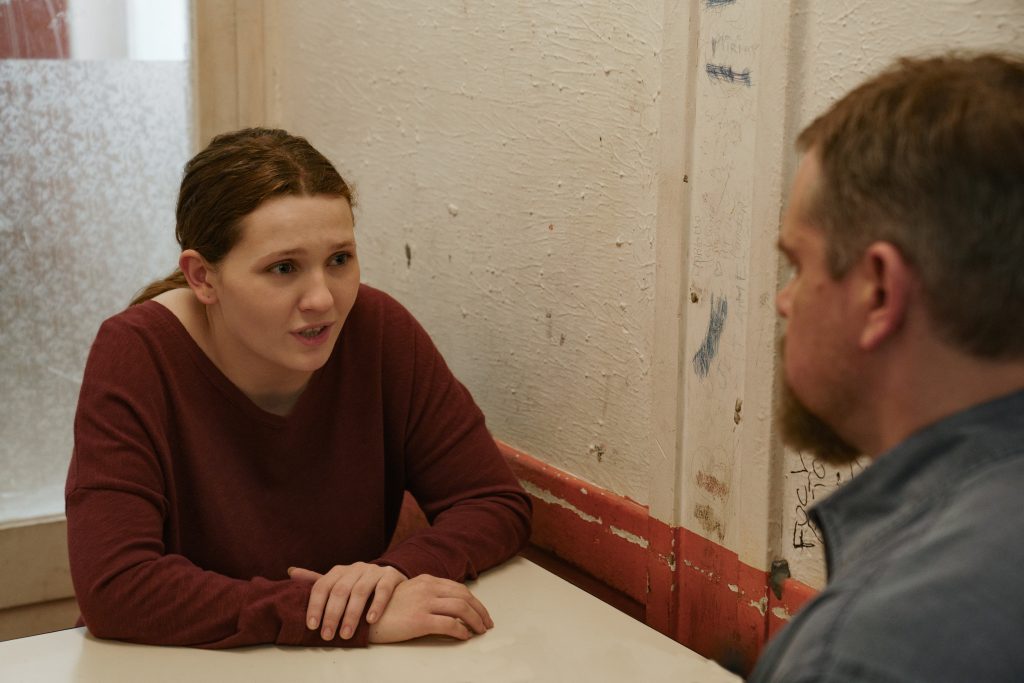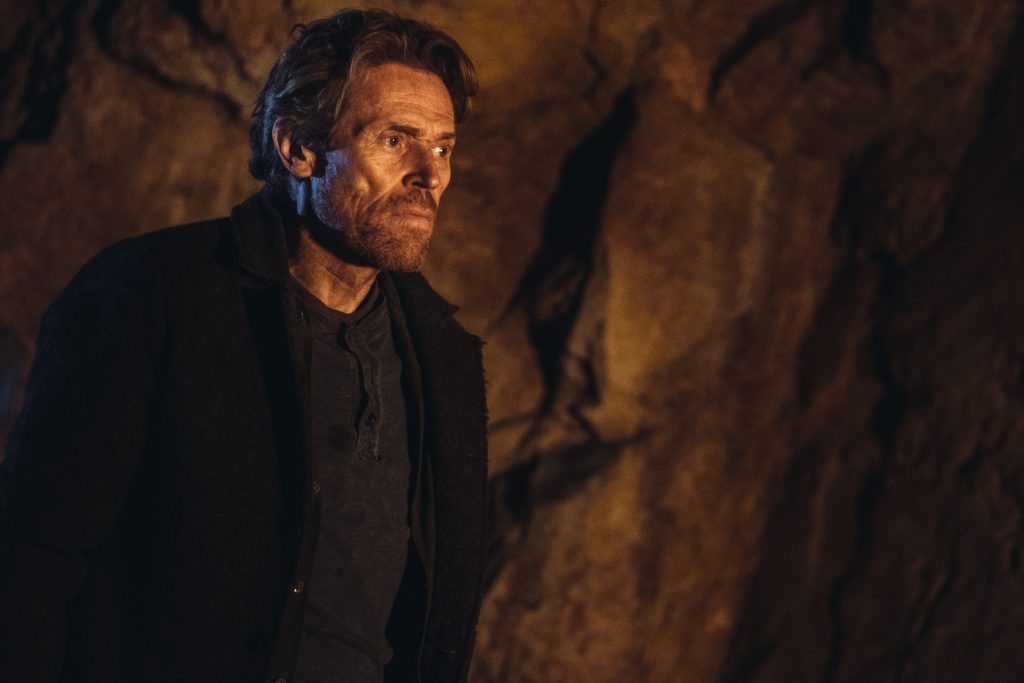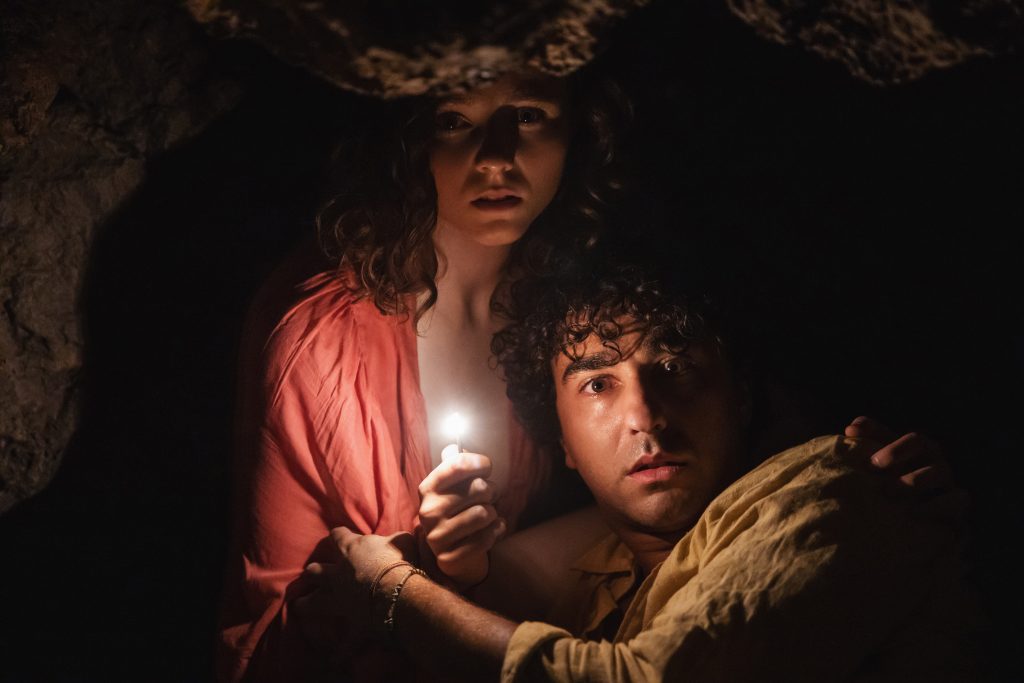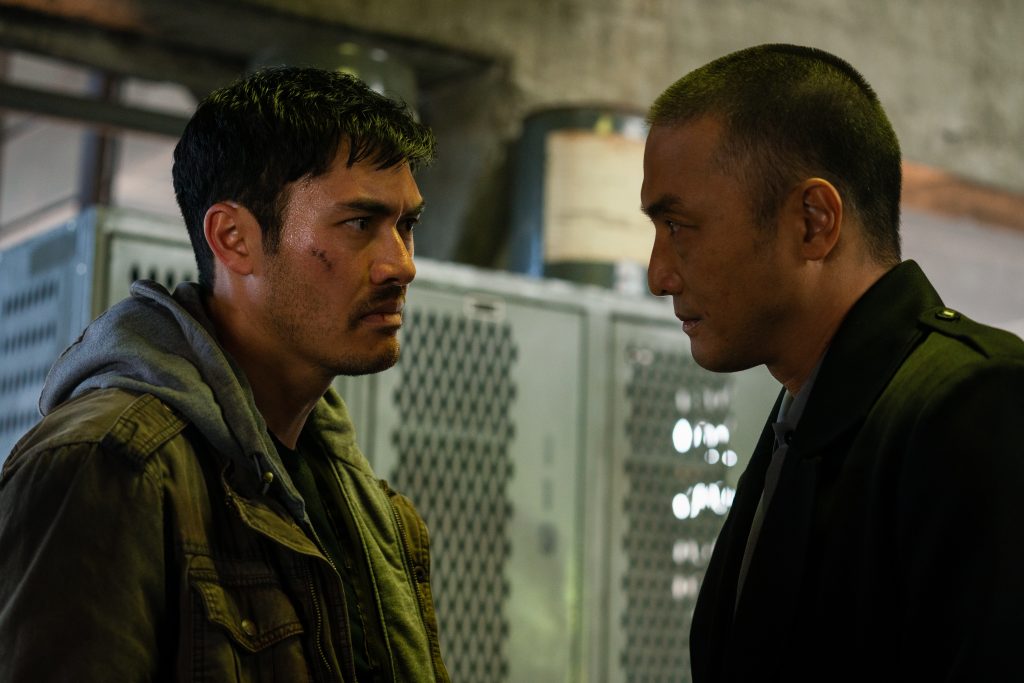July 27, 2021
by Carla Hay

Directed by Jaume Collet-Serra
Culture Representation: Taking place mostly in 1912, in Brazil and England, the action-adventure film “Jungle Cruise” features a racially diverse cast of characters (white, African American Asian and Latino) representing the working-class, middle-class and wealthy.
Culture Clash: A sassy researcher and her fussy botanist brother, who are both from England, enlist the help of a wisecracking American skipper of a ramshackle cruise boat to go to a Brazilian jungle to find a magical tree which has a petal with the power to save lives.
Culture Audience: “Jungle Cruise” will appeal primarily to people who are fans of any Disney adventure films, but might not hold much interest to people who’ve seen better family-friendly adventure films that take place mostly in a jungle.

Overstuffed with generic villains and too rambling for its own good, “Jungle Cruise” offers nothing new or exciting to people who’ve seen higher-quality and more unique adventure films with a jungle at the center of the action. It’s a bland misfire that borrows heavily from 1981’s “Raiders of the Lost Ark” and 1951’s “The African Queen.” Viewers already know how a movie like “Jungle Cruise” is going to end, so “Jungle Cruise” needed to have other elements to make it stand out from similar movies that have a wisecracking male hero and his adventurous love interest who wants to be treated as his equal. Unfortunately, “Jungle Cruise” is stuck in a rut of mediocrity that will make this movie forgettable soon after watching it.
At a total running time of 127 minutes, “Jungle Cruise” over-indulges in characters and scenes that weren’t needed for the movie. Children under the age of 8 and people with very short attention spans might get bored or irritated by the unnecessary convolutions to the plot, which just weigh the story down more than stagnant muck in a jungle swamp. Don’t be surprised if some parts of the movie will make you want to go to sleep.
Directed by Jaume Collet-Serra, “Jungle Cruise” was written by Glenn Ficarra, John Requa and Michael Green. The extraneous plot contrivances seem entirely designed to stretch out the movie’s running time, as if the writers were afraid that that sticking to a simple concept wouldn’t work. In addition, too many parts of the movie seem forced and very fake, such as the romance between the male and female protagonists.
There are also some heavy-handed references to sexism and feminism that are repeated to irksome levels, as if the “Jungle Cruise” filmmakers think viewers are too dimwitted to notice the first three times these same references are in the movie. A running commentary in “Jungle Cruise” is that some of the men can’t believe that the female protagonist is wearing pants. The male protagonist even starts calling her “Pants” as a nickname. It’s a tired joke that wears very thin quickly. And the “feminism” messages in “Jungle Cruise” come across as extremely phony when this movie’s cast members who get top billing are several men but only one woman.
“Jungle Cruise” takes place in 1912, but there are flashbacks throughout the story to previous centuries. The movie opens with a voiceover explanation about the ancient legend that serves as the catalyst for this story. (The musical score during this intro uses an instrumental version of Metallica’s 1991 ballad “Nothing Else Matters,” which is kind of distracting for viewers who know this song.)
In the Legend of the Tears of the Moon, a magical tree called Tears of the Moon exists in the Amazon jungle. This tree has a petal that can cure any illness and break any curse. Over centuries, many explorers sought to find this petal. One of these explorers was a Spanish conquistador from the 1500s named Don Lope de Aguirre (played by Edgar Ramírez), also known as Aguirre, who got injured during his exploration and was found by the guardians of the tree.
After these guardians nursed Aguirre back to health, he demanded that the guardians give him a sacred arrowhead, which is believed to be the key to finding the Tears of the Moon. Aguirre and his conquistadors attacked the guardians, and the jungle fought back. (And yes, there are predictable scenes of trees coming to life and using their branches to tie up people.) As a result, Aguirre was cursed and held captive by the jungle trees for eternity.
In London in 1912, botanist MacGregor Houghton (played by Jack Whitehall) is making a presentation pitch to an all-male group of high-society members in a museum lecture hall. He’s reading a speech from index cards that were written by his much-smarter sister Dr. Lily Houghton (played by Emily Blunt), a researcher who is watching nervously from the balcony. MacGregor wants to convince this group of elites that the Legend of the Tears of the Moon is real, so that they can invest in a trip that MacGregor and Lily want to take to the Amazon jungle to find this magical tree.
MacGregor is fairly unskilled at public speaking (or he didn’t take the time to rehearse his speech), because on the index cards, where Lily wrote in parentheses “pause for dramatic effect,” he actually reads out loud the words “pause for dramatic effect.” MacGregor’s speech is not well-received, to put it mildly. He gets a resounding “no” from the group when requesting funding for the exploration trip.
As McGregor verbally flounders and gets flustered on stage, Lily sneaks off into an off-limits room to find the sacred arrowhead that supposedly will lead whoever possesses it to the Tears of the Moon tree. She pries open a crate, sees the arrowhead and steals it. But before Lily can leave undetected, she runs into a museum official named Sir James Hobbs-Coddington (played by Andy Nyman), a stern and greedy bureaucrat.
He’s about to secretly sell the arrowhead to a visiting German royal called Prince Joachim (played by Jesse Plemons), who sees that Lily has the arrowhead and demands that she hand it over. A predictable chase ensues in the room with some unrealistic choreography involving a ladder that leads to Lily hanging out of a window where she could fall and die. Prince Joachim has her cornered and tells Lily that if she hands over the arrowhead, he will rescue her.
Lily gives Prince Joachim a small box that she says has the arrowhead, but he pushes her off the building anyway. Just then, a double-decker bus with an open top drives by, and Lily lands in the bus. Inside the building, Prince Joachim sees that what’s inside the box isn’t the arrowhead but a duck-hunting decoy shaped like a toucan. Meanwhile, MacGregor gets kicked out of the lecture hall with perfect timing to be outside in the same place as Lily when she landed. MacGregor and Lily make their getaway on the bus. Yes, it’s that kind of movie.
You know the rest: Lily and MacGregor find a boat navigator who can take them to the Porto Vehlo, Brazil, where their Amazon jungle adventure will begin. He’s a skipper named Frank Wolff (played by Dwayne Johnson), who makes a meager living as a tour guide to visitors on his run-down steamer boat La Quila. One of Frank’s identifying qualities is that he constantly likes to tell jokes with bad puns. People will either find it charming or annoying.
For example, while ferrying a group of unlucky tourists who have to listen to his bad jokes, Frank points out a pair of toucans and says, “Only two can play.” Frank’s “wink and nudge” tone is: “Get it? The words ‘two can’ rhyme with ‘toucan.'”
He tells another groan-inducing pun joke to the people on his boat: “I used to work in an orange juice factory, but I got canned. I couldn’t concentrate. Yeah, they put the squeeze on me too.” A young girl on the boat tour voices what a lot of viewers will be thinking about Frank and his cheesy jokes: “Make him stop!”
“Jungle Cruise” is very self-aware that the jokes are silly, but after a while it does get very tiresome and comes across as lazy screenwriting not to have anything else about Frank’s personality that’s memorable. In fact, one of the reasons why “Jungle Cruise” is so disappointing is that none of the characters in this movie has an outstanding personality. You know a movie is bad when it has three villains/antagonists, and they’re just watered-down versions of many other movie villains.
The most obvious villain is Prince Joachim, who spouts cliché lines and does everything a stereotypical villain does but twirl his moustache. Plemons struggles with having a believable German accent in this role. It’s like he’s trying to do a parody of a Christoph Waltz villain, but it doesn’t land very well because Prince Joachim’s dialogue is so witless. Prince Joachim doesn’t come across as cunning or dangerous as much as he comes across as a spoiled and stupid royal who wants his way.
Another villain is Aguirre, who shows up later in the movie. The “Jungle Cruise” filmmakers wouldn’t have taken all that time in the beginning of the movie to tell viewers who Aguirre is without him making an appearance. Aguirre could’ve had an interesting personality and story arc, but he mostly just growls his words and gets into fights.
A third villain, who’s in the movie for less than 10 minutes, is Nilo (played by Paul Giamatti, speaking in a questionable Italian accent), a rival riverboat tour operator who is after Frank for debts that Frank owes to Nilo. If Frank doesn’t pay up, Nilo will get Frank’s boat. Nilo is probably the movie’s most useless character that has a well-known actor in the role. Most people who see “Jungle Cruise” won’t remember who the Nilo character is and what he does for a living.
There’s a time-wasting sequence where Frank impersonates Nilo when he first meets Lily, who’s looking to hire a boat navigator. She soon finds out who the real Nilo is, so her first impression of Frank is that he’s a liar and a con artist. The expected bickering between Lily and Frank ensues, which we all know will eventually lead to them feeling romantically attracted to each other.
MacGregor is a high-maintenance dandy who’s upset that he can’t take many of his possessions—such as a large wardrobe of clothes and tennis rackets—with him on Frank’s boat. Frank’s way of dealing with this issue of MacGregor’s extra luggage is to throw away the luggage in the water. How rude. Later in the movie, it’s implied but not said directly that MacGregor is a semi-closeted gay man. MacGregor talks about how grateful he is that Lily is his sister, because she protects him from being persecuted.
Frank has a pet leopard named Proxima, which is introduced in the movie in a very dubious way: Frank has trained the leopard to scare people away in a restaurant. How is that supposed to be funny? The visual effects for this CGI leopard are not very convincing. It looks every inch like the computer-generated animal that it is.
In fact, all of the visual effects in “Jungle Cruise” are very ho-hum or look bogus enough to be distracting to the movie. The hair and makeup are overdone for Lily, who looks too polished in certain action scenes, where realistically her makeup would’ve sweated off of her face, and her hair would be lot more disheveled.
As for the “jungle adventure,” Frank, Lily and MacGregor have the predictable experiences with jungle tribes, as well as chase scenes with Prince Joachim and his henchmen. There’s also the “eccentric exotic person” who seems to be in every jungle movie. In “Jungle Cruise,” this character is a tribe leader named Trader Sam (played by Veronica Falcón), who becomes an ally to these adventurers. And there are more bad pun jokes from Frank.
But when it’s revealed that Frank has a secret identity, that makes the movie go off the rails. Without giving away too much information, it’s enough to say that Frank’s secret identity meant that he grew up in a country where English is not the primary language. However, Frank has a very American accent throughout the movie. This discrepancy can be explained by Frank living enough of his adult life in the U.S. that he now has an American accent.
But the movie’s tone gets a little too dark for a family film when Frank says that he wants to die. (And it’s not a joke.) It puts a weird damper on the rest of the “adventure,” because it’s an unnecessary death wish for the hero of the story to have, after it’s made obvious that he has romantic feelings for Lily. (And yes, they’ve already kissed each other at this point.) Apparently, no one told Frank that telling a potential lover that you want to die is not the way to romance someone.
Anyway, we all know that this “death wish” is a very manipulative part of the story just to create unnecessary drama. After all, why kill off the hero when there are potential “Jungle Cruise” sequels to be made? Do the filmmakers really think viewers are that stupid?
The chemistry between Johnson and Blunt isn’t convincing enough to make Frank and Lily look like they could be in a real long-lasting relationship. Sparring partners in arguments? Yes. But as romantic partners? No. “Jungle Cruise” tries very hard to make it look like Frank and Lily are a great couple. But after this trip is over, it’s hard to imagine that Frank and Lily would enjoy each other’s company and have a lot to talk about in their everyday lives.
In “Jungle Cruise,” Johnson and Blunt do versions of characters that they’ve already played in other movies. There’s nothing fresh or intriguing about their “Jungle Cruise” performances. Johnson just isn’t very good at portraying someone from an era that happened before he was born. The way he talks and his mannerisms are better suited for roles that take place in his contemporary time period.
Everything about “Jungle Cruise” (which is inspired by the Jungle Cruise theme park ride at Disneyland and Disney World) is supposed to be fun, original and adventurous. Instead, too much of it looks and sounds over-calculated and ripped off from other movies. (And the hackneyed “Jungle Cruise” musical score by James Newton Howard is overbearing at times.)
There’s a pivotal scene in “Jungle Cruise” where an entire jungle lights up in purple, but it looks like it was copied from a pivotal scene in Pixar’s 2017 Oscar-winning film “Coco.” Simply put: “Jungle Cruise” takes no bold or creative risks when it could have. “Jungle Cruise” is more like “Jungle Snooze.”
Walt Disney Pictures will release “Jungle Cruise” in U.S. cinemas and at a premium extra cost on Disney+ on July 30, 2021.

















